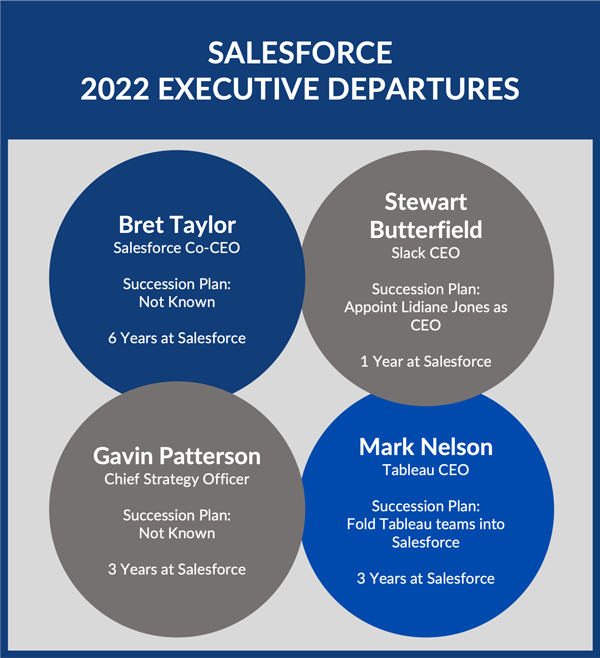- Adam Mansfield
- Reading Time: 4 minutes

Over the last month, there have been announcements tied to four executives leaving Salesforce, catching the attention of investors, Salesforce competitors, and customers while leaving many wondering what this means for Salesforce in 2023.
These executive departures come at a critical time when Salesforce’s revenue guidance for FY23 is coming up short of expectations. Additionally, CEO Marc Benioff and CFO Amy Weaver provided very little insight into their FY24 guidance moving forward during Salesforce’s most recent earnings call.
Several of the executives leaving Salesforce were tied to the company’s largest and most recent acquisitions, Slack and Tableau, leaving investors and customers speculating the cause of this mass exodus and what it all means for them moving forward.
 As customers begin to prepare for their upcoming renewals and negotiations with Salesforce or start to think about whether they want to speak again at Dreamforce ‘23, it is critical to understand what these executive departures mean for Salesforce’s product roadmap and where Salesforce’s focus will be placed in the immediate future.
As customers begin to prepare for their upcoming renewals and negotiations with Salesforce or start to think about whether they want to speak again at Dreamforce ‘23, it is critical to understand what these executive departures mean for Salesforce’s product roadmap and where Salesforce’s focus will be placed in the immediate future.
Customers are likely hoping Salesforce’s focus will be on integrating the acquired solutions in a way that provides actual value back to them, not just a prettier or fuller “Customer 360” slide in their sales deck. Salesforce customers are also hoping for a focus on investing in innovations that will bring tangible value back to them. Put simply, customers will want to know that there is not only stability after these departures, but their subscription dollars are going to be put to good use.
Here is a quick rundown of the recent executive departures:
-
Bret Taylor
Most notably, co-CEO Bret Taylor announced he is stepping down from Salesforce ahead of their most recent Q3 FY23 earnings call. Taylor cites wanting to “return to his entrepreneurial roots” as his reason for leaving Salesforce. This departure comes only a year after Taylor was promoted to the co-CEO position. There is no current succession plan in place, at least not one that has been shared publicly.
Ever since the acquisition of Quip in 2016, Taylor was put on the fast track to this co-CEO role. In fact, whether it is posturing or not, Benioff announced during the earnings call that he wants to do whatever he can to get Taylor to stay on board. Considering this is the second co-CEO to step down after working with Benioff, there have been discussions around whether Benioff can work with a co-CEO. Prior co-CEO Keith Block left Salesforce back in early 2020.
-
Stewart Butterfield
Subsequent to the announcement that Taylor was leaving, Slack CEO Stewart Butterfield announced his plan to leave. Taylor was a fundamental player in Salesforce’s acquisition of Slack in 2021 and bringing Stewart into the Salesforce family, raising the question of how connected these two departures are to each other. Slack’s acquisition was Saleforce’s largest acquisition to date, totaling $27.1B. Butterfield explicitly claimed he won’t be pursuing anything entrepreneurial, but whether Butterfield will stay true to that or become involved in a company Taylor starts, only time will tell. Stewart will be succeeded by Lidiane Jones.
Additionally, Salesforce is losing Tamar Yehoshua, Slack’s product chief, and Jonathan Prince, senior vice president in charge of marketing, brand and communications.
-
Mark Nelson
Next, Tableau CEO Mark Nelson announced that he was also leaving, and his last day was December 1, 2022. Tableau was acquired back in 2019 for $15.7B. Nelson took over as Tableau CEO after Adam Selipsky left to become CEO of AWS back in early 2021.
Salesforce has been struggling to reaccelerate Tableau growth, and it has clearly been an area of concern both inside and outside of Salesforce. There also is no plan to replace Nelson and bring in a new Tableau CEO. Instead, it was announced during the Q3 FY23 earnings call, by Taylor, that the teams tied to Tableau are actually going to be folding under Salesforce.
-
Gavin Patterson
Lastly, a month ago it was announced that Gavin Patterson would be leaving his role as Chief Strategy Officer. Prior to becoming Chief Strategy Officer back in August of 2022, Patterson was Chief Revenue Officer. When Gavin became Chief Strategy Officer, it was also announced that Brian Millham would become the new COO and his role would be to lead the customer success organization at Salesforce as well as global sales.
In addition to these more recent executive departures, there have also been some key executives that left in 2021, including: Stephanie Buscemi (CMO), Adam Blitzer (Executive VP and GM), Larry Shurtz (Executive VP of North American Enterprise), and Andrew Fenton (COO).
What Salesforce Customers Need to Know
If you are a Salesforce customer, it is critical that you get ahead of this. You should push your account executives, or any elevated points of contact you or others within your organization have relationships with and ask for discussions and meetings in order to get assurances around what this means for Salesforce’s roadmap and your go-forward relationship. Use these discussions to try to figure out what plans are being put in place to overcome the challenges of these executives leaving in such a short period of time.
If you are a Slack or Tableau customer, it may also be worth focusing specifically on what these departures mean given two of the departures were directly tied to these solutions, and Taylor’s vision was a driving force behind the Slack acquisition.
Salesforce will be quick to give assurances to the market and investor community, but as a long-term customer that has paid significant subscription fees, you need to get your own assurances that will ultimately drive expected value back along with a hopefully strengthened relationship.
Related Blogs
Salesforce Increasing Pricing and Adding Agentforce Options: What Customers Need to Know Now
Salesforce’s New Agentforce Pricing: What Customers Should Know
Salesforce Product Changes: What You Need to Know and How to Navigate Them
About the Author
